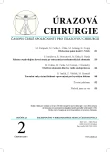-
Medical journals
- Career
Nailing of the calcaneal bone C-NAIL
Authors: Martin Pompach 1; Martin Carda 1; Luboš Žilka 2; Michael Amlang 3; Hans Zwipp 3
Authors‘ workplace: Department of traumatology, Pardubice, Hospital of region Pardubice 1; Úrazová chirurgie, Nemocnice pardubického kraje, a. s., Pardubická nemocnice 1; MEDIN a. s., Nové Město na Moravě 2; Medin, a. s., Nové Město na Moravě 2; Department of traumatology, University Hospital of Carl Gustav Carus, Dresden, Germany 3; Úrazová a rekonstrukční chirurgie, Univerzitní klinika, Carl Gustav Carus, Drážďany, Německo 3
Published in: Úraz chir. 23., 2015, č.2
Overview
Introduction:
The authors present the results of calcaneal fracture treatment using a new method with the calcaneal nail (C-NAIL).Aim:
The aim is to evaluate the results of calcaneal fracture treatment using a new method with the C-NAIL and compare them with the results of calcaneal fracture treatment using other implants.Material and methods:
At the Department of Traumatology Surgery in Pardubice Hospital, the authors performed a total of 107 calcaneal fracture surgeries over a period of 3 years using a new minimally invasive method – C-NAIL. The internationally accepted AOFAS (American Orthopaedic Foot and Ankle Society) scoring scheme was used to evaluate the performance results.Results:
The authors evaluated the AOFAS score six months and one year after the patient’s surgery. The measured values ranged from 65-100 points, with an average of 93.0 after 6 months and 94.1 at 12 months after the surgery. They evaluated the restoration of the crossing Böhler angle in the traumatic values of 6.2° to 31.8°. After 3 months, the Böhler angle slightly decreased to 29.6° and after 12 months, to 28.3°. They recorded 2 cases of wound edge necrosis (1.9%) and one case of deep infection (0.93%).Conclusion:
C-NAIL enables mini-invasive reposition of the articular surface and high biomechanical stability of calcaneal fractures with a significantly low incidence of complications.Key words:
Calcaneal nail, C-NAIL, calcaneal fractur.
Sources
1. FREEMAN, B., DUFF, S., ALLEN, P. et al. The extended lateral approach to the hindfoot. Anatomical basis and surgical implications. Bone Joint Surg. 1998, 80, 139–142.
2. GOLDZAK, M., MITTLMEIER, T., SIMON, P. Locked nailing for the treatment of displaced articular fractures of the calcaneus: description of a new procedure with calcanail. Eur J Orthop Surg Traumatol. 2012, 22, 345–349.
3. GOLDZAK, M., SIMON, P., MITTLMEIER, T. et al. Primary stability of an intramedullary calcaneal nail and an angular stable calcaneal plate in a biomechanical testing model of intraarticular calcaneal fracture. Injury. 2014, Suppl 1, S49–53.
4. HEIER, KA., INFANTE, AF., WAILLING, AK. et al. Open fractures of the calcaneus: soft tissue injury determines outcome. J Bone Joint Surg Am. 2003, 85-A, 2276–2282.
5. KITAOKA, H., ALEXANDER, I., ADELAAR, R. et al. Clinical rating systems for the ankle, hindfoot, midfoot, hallux and lesser toes. Foot Ankle Int. 1994, 15, 349–353.
6. POMPACH, M., CARDA., M., VANÁČ., J. et al. Zlomenina patní kosti – život ohrožující zranění. Úraz chir. 2006, 14, 7–11. ISSN: 1211-7080.
7. RAMMELT, S., GAVLIK, JM., BARHEL, S. et al. The value of subtalar arthroscopy in the management of intra-articular calcaneus fractures. Foot Ankle Int. 2002, 23, 906–916.
8. ZWIPP, H., RAMMELT, S. Subtalare Arthrodese mit Calcaneus-Osteotomie. Orthopäde. 2006, 35, 387–404.
9. ZWIPP, H., RAMMELT, S., AMLANG, M. et al. Osteosynthese dislozierter intraartikulärer Kalkaneusfrakturen. Operative Orthopädie und Traumatologie. 2013, 11–13.
10. ZWIPP, H., RAMMELT, S., BARHEL, S. Kalkaneusfraktur. Unfallchirurg. 2005, 108, 737–760.
Labels
Surgery Traumatology Trauma surgery
Article was published inTrauma Surgery

2015 Issue 2
Most read in this issue- Treatment of the radial head fractures by endoprothesis
- Nailing of the calcaneal bone C-NAIL
- Injury of the hand with high pressure injection of heterogeneous subtances
- Factors infuencing blood loss after osteosynthesis of trochanteric fractures
Login#ADS_BOTTOM_SCRIPTS#Forgotten passwordEnter the email address that you registered with. We will send you instructions on how to set a new password.
- Career

